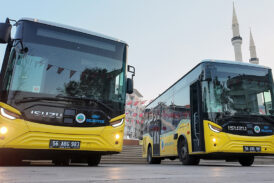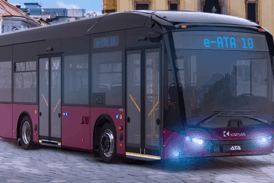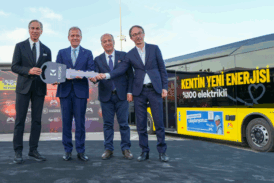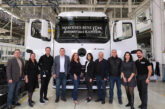Daimler-Benz Plug-in-Hybrid
Why plug-in hybrids are an important pillar on the way to emission-free mobility
The blue A-Class looks inconspicuous at first glance. It seems to be just another A-Class vehicle. A closer look is needed in order to reveal its true nature. The type designation at the rear is enough for people who are familiar with such things. But all is revealed at the latest when the compact sedan softly and almost silently comes to a halt and the driver steps out of the vehicle. There, where you would expect the fuel filler cap to be, she inserts not a pump nozzle but a Type 2 power plug. So the vehicle must be an A 250e (combined fuel consumption, weighted: 1.6–1.4 l/100 km, combined electricity consumption, weighted: 15.3–14.8 kWh/100 km, combined CO₂ emissions, weighted: 36–32 g/km* **). A plug-in hybrid variant of the A-Class was presented for the first time in August 2019. The first units of this vehicle are now in the hands of customers.

The demand for this model is currently very high, as it is for all of the plug-in hybrids bearing the famous star logo. In Europe, Mercedes-Benz sold four times as many cars with a dual drive system in the first half of 2020 as in the same period of last year, and the trend is continuing. On the German market, sales are of course being further boosted by the economic stimulus program that was passed by the federal government in June. This program provides up to €6,750 in subsidies for a plug-in hybrid car if you combine the environmental premium with the innovation premium. The automaker finances half of the environmental premium.


During the first six months of 2020, almost 50,000 plug-in hybrid vehicles of all makes were registered for the first time in the German market. That was more than in all of 2019, despite the effects of the coronavirus pandemic. In the third quarter of 2020, Germany’s Federal Motor Transport Authority (KBA) registered a further 56,000 new plug-in hybrids. In July and August, the best-seller of any brand was the Mercedes-Benz A 250e, while the top seller in September was the Mercedes-Benz GLC 300e (combined fuel consumption, weighted: 2.2 l/100 km, combined electricity consumption, weighted: 16.5 kWh/100 km, combined CO₂ emissions, weighted: 50 g/km* **).
 The demand for Mercedes-Benz cars equipped with plug-in hybrid drive systems is currently very high. In September, no other plug-in hybrid car of any brand posted as many new registrations as did the GLC 300e (weighted fuel consumption, combined: 2.2 l/100 km, weighted electricity consumption, combined: 16.5 kWh/100 km, weighted CO₂ emissions, combined: 50 g/km* **)
The demand for Mercedes-Benz cars equipped with plug-in hybrid drive systems is currently very high. In September, no other plug-in hybrid car of any brand posted as many new registrations as did the GLC 300e (weighted fuel consumption, combined: 2.2 l/100 km, weighted electricity consumption, combined: 16.5 kWh/100 km, weighted CO₂ emissions, combined: 50 g/km* **)

It’s probably no coincidence that the more “two-hearted” vehicles there are on the road, the more hotly their role for the future of mobility will be debated. Because mobility inevitably also has something to do with one’s lifestyle and for some people is even an expression of personal freedom, this discussion can sometimes even get very emotional. Unfortunately, that sometimes makes people ignore the fact that this discussion is complex — much more complex than punchy slogans such as “the best of both worlds” on the part of hybrid fans or “state-aided climate fraud” on the part of the skeptics would indicate. We believe that it’s the job of Daimler Magazine to illuminate complex debates in all of their facets — and that’s precisely what we aim to do here with regard to the controversial debate about plug-in hybrid cars.

The goal is clear: CO₂-neutral mobility
Torsten Eder has probably answered the question as to his personal opinion on the topic of plug-in hybrids more often than anybody else at Daimler. He heads the Powertrain development unit at Mercedes-Benz, his responsibilities include the development of both electric motors and combustion engines. “Our drive system strategy clearly pursues an electric first approach. Our goal is CO₂-neutral mobility,” Eder says.

Last year, Daimler announced its Ambition2039 strategy, which aims to make the entire company and its fleet of new vehicles climate-neutral by 2039. Although the planned timeframe of almost two decades might seem long, anyone familiar with the processes in the automotive industry will know that it generally takes several years for a vehicle to proceed from the advanced development phase to series production. Which means: Two decades is less than three product cycles. This makes the transformation correspondingly challenging for the entire organization — especially for the motor and engine developers, of course. After all, the drivetrain is probably the most important factor when it comes to reducing carbon dioxide emissions, as an electric motor moves a vehicle without producing any local CO₂ emissions.

Plug-in hybrids as a bridge between the technologies
“We also have to view the current global situation realistically,” says Eder. “Battery-electric vehicles aren’t the right choice for everyone at the moment. One of the reasons for this is that the charging infrastructure still has many gaps in various regions.” Mercedes-Benz always aims to offer its customers the right vehicle for their individual needs. That’s why its drive system strategy rests on three pillars. The first pillar consists of the all-electric EQ models. Five of them will be on the market by the end of the year. The second pillar consists of the plug-in hybrids that have not only an electric machine onboard but also a gasoline or diesel engine. The third pillar encompasses cutting-edge combustion engines whose efficiency is enhanced by the built-in 48-volt technology.
Torsten Eder heads Mercedes-Benz’ power train development department and drives a plug-in hybrid himself.In this strategy, the plug-in hybrid vehicles bridge the gap between the two drive technologies. “They provide the benefits from both worlds: You drive using the all-electric mode in the city, while on long journeys you benefit from the combustion engine’s range and the corresponding infrastructure,” says Eder.
An electric range greater than the average daily distance driven by German drivers
There is also a side effect that is by no means negligible: Plug-in hybrids are the perfect means of getting into electric mobility for customers who are still unsure about all-electric vehicles. In a sense, they whet the appetite for more. Anyone who has driven a comparatively large car like the E-Class or S-Class without having a combustion engine running is familiar with the almost majestic feeling that this produces. This feeling even affects someone like Torsten Eder, who has to deal with vehicle drive systems on a daily basis. Eder drives a plug-in hybrid version of the E-Class. Only the electric machine is in action when he commutes to and from work.
Statistics show that most Europeans have similar uses for their cars. The latest Mobilität in Deutschland (Mobility in Germany) study was published in 2017. It shows that Germans drive an average of 39 kilometers per day. This value is between 30 and 40 kilometers in most other European countries as well. All of the current plug-in hybrid models from Mercedes-Benz have a minimum all-electric range of around 50 kilometers. The plug-in hybrid variants of the GLE and the upcoming S-Class can even run for approximately around 100 kilometers when their batteries are fully charged. This means that the average European driver can use a plug-in hybrid from Mercedes-Benz to travel purely electrically on a daily basis.
The average German motorist drives 39 kilometers per day. Depending on the model in question, a plug-in hybrid from Mercedes-Benz has a purely electric range of about 50 to 100 kilometers.
The plug-in hybrid is more efficient — even without external charging
This claim admittedly leads directly to what is probably the biggest criticism of the dual drive system car in the public debate. It goes that motorists will buy a plug-in hybrid simply to have a good conscience and benefit from the environmental premium, the tax breaks, and the “E” license plate number – but ultimately only drive that car using the combustion engine.
The truth is that all of the plug-in hybrid cars from Mercedes-Benz are designed so that they can be regularly recharged externally and that they generally use the electric motor. The plug-in hybrids from the compact segment (for example, the A 250e mentioned at the beginning) don’t even have a separate starter for the combustion engine any more. These cars are started by the electric machine alone.
In addition, Daimler is strongly promoting the creation of a smart and dense network of charging stations. On the one hand, it is doing this by means of the service Mercedes me Charge, which provides customers with access to one of the world’s largest charging networks. Another example is the company’s involvement in the joint venture IONITY, which is building a high-performance fast-charging network in Europe. On the other, Daimler offers services such as Mercedes-Benz Wallbox Home, which enables customers to quickly and safely recharge vehicle batteries at home. And there are further ideas how to incentivize customers to use the electric motor of their plug-in hybrid vehicle wherever possible – for example with a bonus program.
But let’s consider a worst case scenario: How efficient is a plug-in hybrid when it is not charged externally? This is precisely what two colleagues from powertrain development wanted to find out under real-life conditions. Matthias Klöpfer and Tom Hinsken, who usually work on the functions and the application of the hybrid transmission, tested two GLEs with comparably strong drive systems along exactly the same route and at the same time. Hinsken drove a conventionally powered GLE 350 d (combined fuel consumption: 7.4–6.7 l/100 km, combined CO₂ emissions: 195–177 g/km*). Klöpfer drove a GLE 350de diesel hybrid (combined fuel consumption, weighted: 1.3–1.1 l / 100 km, combined electricity consumption, weighted: 28.7–25.4 kWh/100 km, combined CO₂ emissions, weighted: 34–29 g/km* **), whose battery was at zero charge at the beginning of the test. At first glance, the hybrid seems to have a disadvantage in this competition, because the additional drive system makes it around 400 kilograms heavier.
However, the surprising result was that the heavier GLE featuring a plug-in hybrid drive consumed about 25 percent less diesel during the spin through the Black Forest than its counterpart equipped with a combustion engine. How was this possible? Physics provides the answer, and the magic word is “recuperation” — energy recovery. The hybrid can brake electrically when it slows down or drives down slopes. This turns the electric drive system into a kind of generator that recharges the battery. The recovered energy can then be used for driving purposes or stored in the battery so that the vehicle can, for example, cover the last few kilometers to its destination completely electrically. A vehicle equipped only with a combustion engine merely converts the braking energy into heat that is lost.
Comparative drive in the Black Forest: Thanks to energy recovery, the plug-in hybrid GLE consumes less fuel than its conventionally powered sister model, even though it is around 400 kilograms heavier.
Automatically achieving the best mix of electric motor and combustion engine
However, drivers don’t have to actively concern themselves with any of this while they are traveling. That’s because the hybrid vehicle has an intelligent drive management system that selects the ideal combination of combustion engine and electric motor. In doing so, it also takes into account the destination entered into the navigation system as well as the speed limits along the route. Matthias Klöpfer explains: “The operation strategy knows how many kilometers we still have to drive to reach our destination and that the destination is located in a city. Among other things, this causes the vehicle to independently switch on the combustion engine when it is on the highway so that it can save up the energy in the battery for the last stretch of the route.” This is the most convenient way to drive a plug-in hybrid from Mercedes-Benz. Naturally, drivers can also select various other driving modes so that the drive system mix conforms to their personal preferences.
Incidentally, the following episode of our series explains how plug-in hybrid technology works in detail: Easy Tech. The standard consumption of plug-in hybrids is regulated by law
The second major criticism regularly leveled against plug-in hybrids is also related to fuel consumption. What is specifically criticized is the consumption value that Mercedes-Benz as a carmaker gives in its online configurator and in the advertising for its plug-in hybrids. These values are as low as between 1.3 and 1.1 liters of diesel for the GLE 350 de that took part in the comparative test drive in the Black Forest. This vehicle is equipped with a 143 kW/194 hp diesel drive assembly and with an electric machine that produces 100 kW/136 hp of output. Can this really be true?
It isn’t the first time that Torsten Eder has to answer this question. “You need to keep in mind that this is the certified fuel consumption. It is based on statutory requirements and is what makes it possible to compare the efficiency of different vehicles from various manufacturers,” he says. During the certification procedure, the standard consumption is determined according to the regulations of the WLTP, the Worldwide Harmonized Light Test Vehicle Test Procedure. In Germany, this calculation is also regulated by the Pkw-EnVKV, an abbreviation that stands for Car Energy Consumption Labeling Regulation, which still requires consumption information in advertising to be quoted according to the NEDC, the New European Driving Cycle. To make this point clear: Mercedes-Benz has to give the NEDC consumption value in all of its adverting measures — anything else would violate applicable law.
But does this automatically mean that the certified fuel consumption value is unrealistic? Not necessarily. It goes without saying that fuel consumption is higher when a plug-in hybrid is primarily powered by the combustion engine. And nobody ever claimed the contrary.
In his job, Matthias Klöpfer works on the transmissions of our plug-in hybrids. As an expert, he knows that you can only exploit the advantages of a plug-in hybrid if you regularly recharge it.
Moreover, it’s also true that drivers won’t need a single drop of fuel if they always recharge their plug-in hybrids and don’t travel long distances. As has been mentioned, the current range of plug-in hybrids from Mercedes-Benz cover the average of 39 kilometers that a German driver travels per day on one battery charge without needing to activate the combustion engine, provided the driver has a normal driving style. According to Torsten Eder, the formula for doing this is simple: “The more often a customer recharges the vehicle, the lower the actual fuel consumption will be. In short, you benefit from recharging.”
The trunk is somewhat smaller and the purchase price can be higher
And what about the purchase price? Which type of drive system is better in this regard? It’s true that the more complex drive technology of plug-in hybrids tends to make them somewhat more expensive than a comparable vehicle equipped with a combustion engine.
Because vehicle prices vary from one market to another, we did a sample calculation on the basis of the price list that was valid in Germany in July. It showed that the GLE 350de with standard equipment cost around €4,000 more than the comparable GLE 350d. The difference between the C 300 sedan (combined fuel consumption: 6.5–6.0 l / 100 km, combined CO₂ emissions: 149-136 g/km*) and the C 300e sedan (combined fuel consumption, weighted: 2.0–1.8 l / 100 km, electricity consumption, weighted: 15.6–13.4 kWh/100 km, combined CO₂ emissions, weighted: 47-41 g/km* **) amounts to slightly less than €2,000. However, many countries currently provide plug-in hybrids with tax benefits or even with purchasing incentives — these can often offset the higher purchase price. However, there are also models to which this rule of thumb doesn’t apply. For example, the A 250e compact sedan and the A 250 compact sedan (combined fuel consumption: 6.4–5.9 l / 100 km, combined CO₂ emissions: 146-135 g/km* **) cost about the same, and the basic equipment version of the hybrid variant is even about €200 cheaper than the conventionally powered vehicle.
Because we are comparing combustion engine vehicles with plug-in hybrids, we naturally also have to mention the following fact: The “two hearts” not only make hybrid cars a bit heavier but also call for a different arrangement of the components – the additional battery in particular needs space.
The installation of the battery forced the developers to rethink the arrangement of the components inside the vehicle. Pictured here is the A-Class production line at the Rastatt plant. However, our developers are also learning in this respect. Although the plug-in hybrids of the current C-Class, for example, still have a ledge in the trunk to hide the battery, the compact hybrids that were presented last year no longer have this, their trunks’ structure is hardly affected by the hybridization. This was achieved by positioning the exhaust system centrally under the vehicle floor, while the fuel tank is located in the axle assembly space. As a result, there is enough room under the rear seats for the high-voltage battery. This body assembly gives the A 250e compact sedan a trunk volume of 345 liters.
Plug-in hybrids are flexibly produced on the same assembly line
Incidentally, despite featuring a dual drive train, a plug-in hybrid model isn’t automatically more difficult to produce than a Mercedes-Benz car with a conventional drive system. Take the A-Class, for example: At the Mercedes-Benz plant in Rastatt, the plug-in hybrid variants of this vehicle are produced on the same assembly line as those equipped with gasoline or diesel engines. The same applies to the production of the CLA at the Mercedes-Benz plant in Kecskemét, Hungary. (Mercedes-Benz CLA 250e: combined fuel consumption, weighted: 1.6–1.4 l / 100 km, combined electricity consumption, weighted: 15.5–14.7 kWh/100 km, combined CO₂ emissions, weighted: 37-31 g/km * **)
Production of the A-Class in Rastatt: The plug-in hybrid variants are flexibly produced on the same assembly line as conventionally powered vehicles.
“The new CLA is the first hybrid model produced in Kecskemét. It required the preparations to be even more complex than usual for the run-up to production,” says Lívia Borsai, who is responsible for qualification measures at the Mercedes-Benz facility in Hungary. “We trained the employees here for several months to prepare them for the specific production processes of the plug-in hybrid models and the corresponding work safety measures.” Tamás Berki from the location planning unit adds, “We were well prepared for the run-up. The team did a really great job, as you can see from the fact that we introduced the new hybrid models while our usual production operations were running, even though the process was accompanied by new technical conditions and new work safety measures.” Here’s why the Kecskemét production team was so successful: “We assembled the first prototypes more than one year before series introduction was set to begin, and we did this in a hall that was specifically equipped for this purpose. That was a big process improvement at our plant,” Berki explains.
The hybrid module that powers the compact hybrids takes up very little space. The electric motor is integrated into the eight-speed dual-clutch transmission. The electric machine on its own produces 75 kW/102 hp. Connected to it is a high-voltage lithium-ion battery with a total capacity of about 15.6 kWh. This battery is manufactured by Accumotive, a wholly-owned subsidiary of Mercedes-Benz in the German town of Kamenz.
“When we started the series introduction of the hybrid vehicles here in Rastatt, I was surprised by how much pioneering technology fit into our existing compact models,” recalls Marcel Ehret, who works at the global assembly introduction unit for compact vehicles. “The family of compact vehicles has a limited amount of installation space. This makes the integration of the high-voltage components challenging. However, the Mercedes-Benz plant in Rastatt in particular has many years of experience with electric vehicles, starting with the A-Class E-CELL from 2010.” Ehret is proud of the teamwork that made the smooth progress of the A250e in Rastatt possible. He says that “this A-Class is a great example of how the latest generation of compacts enables motorists to drive purely electrically in everyday life.”
If plug-in hybrids are a compromise, then they are a pretty good one
Driving experience is the key concept. Motorists can gain that with the more than 20 plug-in hybrid variants that will be in the Mercedes-Benz portfolio by the end of the year. And these hybrids are found in all segments. “We are thus meeting the rising demand,” says Christina Currle-Hamel, who heads the product management for the compact vehicles of Mercedes-Benz. “We are thus meeting the rising demand,” says Christina Currle-Hamel, who heads the product management for the compact vehicles of Mercedes-Benz. “We are already offering six compact models with plug-in hybrid technology,” she says. “We think it makes sense to offer this efficient drive type in this vehicle class as well. In this way, we make it easy for a wide range of customers to switch to electric mobility.”
There’s no doubt that the great interest and the big jump in demand for plug-in hybrids demonstrate that this technology has many fans. Everyone will ultimately have to decide for themselves whether it is a compromise. However, the facts really allow only one conclusion: If plug-in hybrids are a compromise, they are a pretty good one. Especially because they make moving to electric mobility attractive for the many people who are still skeptical about purely battery-electric vehicles. These cars will almost certainly get people excited about driving with battery drive systems.







![OTOKAR [ad id='30280']](https://tasiyanlar.com/wp-content/uploads/2025/11/OTOKAR-SERVIS-GUNLERI-KASIM-2025-BANNER-1200x110-1.gif)
![MAN BANNER – 7 kasım giriş 8 aralık çıkış [ad id='38440']](https://tasiyanlar.com/wp-content/uploads/2025/11/MAN_WebBanner_Tasiyanlar_TGX2025_1200x110.gif)
















![1/C Reklam CUMMINS[ad id='5542']](https://tasiyanlar.com/wp-content/uploads/2025/05/On-HighwayDigitalBanner_PowerOnward_April25_1200x110px_Turkish_1.2_5.jpg)





